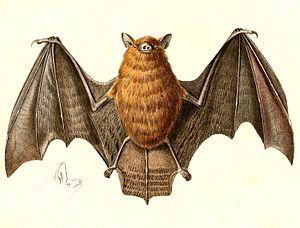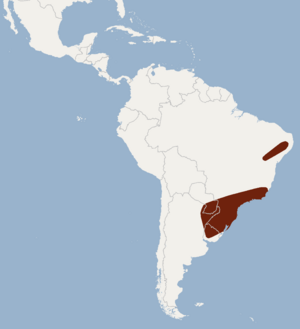Red myotis facts for kids
The red myotis (Myotis ruber) is a type of bat found in parts of South America. It lives in countries like Argentina, Brazil, Paraguay, and Uruguay. This small bat belongs to a group called "vesper bats," which are common bats that fly at night.
Quick facts for kids Red myotis |
|
|---|---|
 |
|
| Conservation status | |
| Scientific classification | |
| Genus: |
Myotis
|
| Species: |
ruber
|
 |
|
Contents
What is a Vesper Bat?
The red myotis is part of a large family of bats called Vespertilionidae, often known as "vesper bats" or "evening bats." These bats are found all over the world, except for Antarctica. Most vesper bats are small and eat insects. They are known for using echolocation to find their way around and hunt in the dark.
Appearance of the Red Myotis
The red myotis is a medium-sized bat. It has soft, reddish-brown fur on its back and lighter fur on its belly. Its wings are dark, and its ears are fairly long. Like other bats, its wings are actually modified front limbs, allowing it to fly.
Where the Red Myotis Lives
This bat lives in tropical and subtropical areas of South America. You can find it in forests, especially near water sources like rivers and streams. They often roost, or rest, in hollow trees, caves, or even old buildings during the day. They prefer places that are dark and quiet to sleep safely.
What the Red Myotis Eats
The red myotis is an insectivore, meaning it eats insects. It mostly hunts flying insects like moths, beetles, and mosquitoes. It uses echolocation to find its prey in the dark. Echolocation is like sending out sound waves and listening for the echoes to create a "sound map" of its surroundings. This helps the bat know where objects and insects are, even in complete darkness.
Life Cycle and Reproduction
Bats usually have one or two babies at a time. Baby bats are called pups. They are born without fur and are completely dependent on their mothers. The mother bat feeds her pup milk until it is old enough to fly and hunt on its own. The exact details of the red myotis's reproduction are still being studied, but generally, bats give birth during warmer months when insects are plentiful.
Conservation Status
The red myotis is currently listed as "Near Threatened" by the International Union for Conservation of Nature (IUCN). This means that while it's not critically endangered right now, its population could become threatened in the future. The main threats to this bat include habitat loss due to deforestation and changes in land use. Protecting its forest homes is important for its survival.
See also
 In Spanish: Myotis ruber para niños
In Spanish: Myotis ruber para niños


